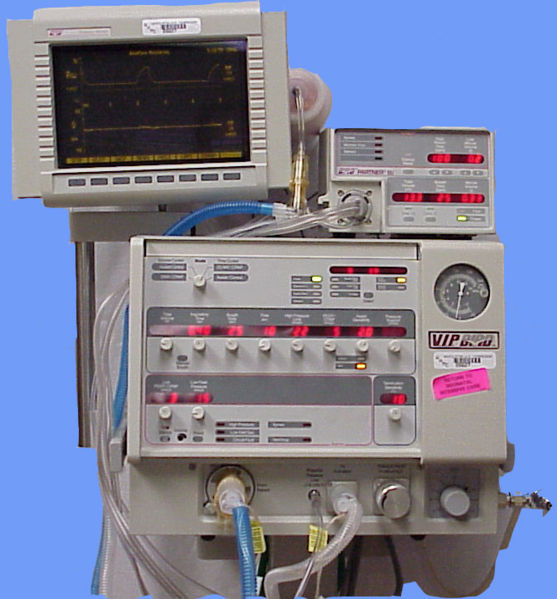Mechanical ventilation historical perspective: Difference between revisions
| Line 13: | Line 13: | ||
[[Image:VIP Bird2.jpg|left|thumb|Mechanical ventilator]] | [[Image:VIP Bird2.jpg|left|thumb|Mechanical ventilator]] | ||
The design of the modern positive-pressure ventilators were mainly based on technical developments by the military during World War II to supply oxygen to fighter pilots in high altitude. Such ventilators replaced the iron lungs as safe endotracheal tubes with high volume/low pressure cuffs were developed. The popularity of positive-pressure ventilators rose during the polio epidemic in the 1950s in Scandinavia and the United States. Positive pressure through manual supply of 50% oxygen through a [[tracheostomy]] tube led to a reduced mortality rate among patients with polio and respiratory paralysis. However, because of the sheer amount of man-power required for such intervention, positive-pressure ventilators became increasingly popular. | The design of the modern positive-pressure ventilators were mainly based on technical developments by the military during World War II to supply oxygen to fighter pilots in high altitude. Such ventilators replaced the iron lungs as safe endotracheal tubes with high volume/low pressure cuffs were developed. The popularity of positive-pressure ventilators rose during the polio epidemic in the 1950s in Scandinavia and the United States. Positive pressure through manual supply of 50% oxygen through a [[tracheostomy]] tube led to a reduced mortality rate among patients with polio and respiratory paralysis. However, because of the sheer amount of man-power required for such intervention, positive-pressure ventilators became increasingly popular. | ||
<br clear="left"/> | |||
==References== | ==References== | ||
Revision as of 21:20, 28 February 2013
|
Mechanical ventilation Microchapters |
|
Mechanical ventilation historical perspective On the Web |
|---|
|
American Roentgen Ray Society Images of Mechanical ventilation historical perspective |
|
Risk calculators and risk factors for Mechanical ventilation historical perspective |
Editor-In-Chief: C. Michael Gibson, M.S., M.D. [1] Associate Editor(s)-in-Chief: Vishnu Vardhan Serla M.B.B.S. [2]
Historical Perspective
Vesalius was the first person to describe mechanical ventilation by inserting a reed or cane into the trachea of animals and then blowing into this tube.[1]
Negative Pressure Machines

The iron lung, also known as the Drinker and Shaw tank, was developed in 1929 and was one of the first negative-pressure machines used for long-term ventilation. It was refined and used in the 20th century largely as a result of the polio epidemic that struck the world in the 1950s. The machine is effectively a large elongated tank, which encases the patient up to the neck. The neck is sealed with a rubber gasket so that the patient's face (and airway) are exposed to the room air.
Positive Pressure Machines

The design of the modern positive-pressure ventilators were mainly based on technical developments by the military during World War II to supply oxygen to fighter pilots in high altitude. Such ventilators replaced the iron lungs as safe endotracheal tubes with high volume/low pressure cuffs were developed. The popularity of positive-pressure ventilators rose during the polio epidemic in the 1950s in Scandinavia and the United States. Positive pressure through manual supply of 50% oxygen through a tracheostomy tube led to a reduced mortality rate among patients with polio and respiratory paralysis. However, because of the sheer amount of man-power required for such intervention, positive-pressure ventilators became increasingly popular.
References
- ↑ Chamberlain D (2003) "Never quite there: A tale of resuscitation medicine" Clinical Medicine, Journal of the Royal College of Physicians' 3 6:573-577